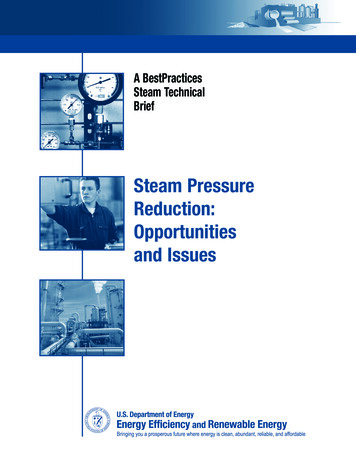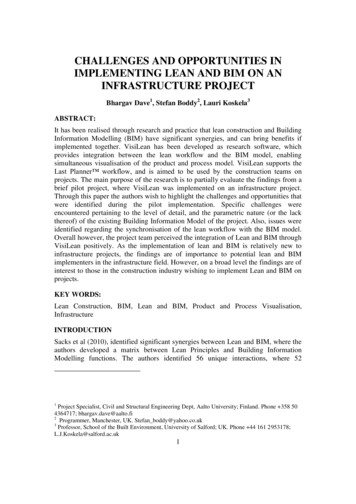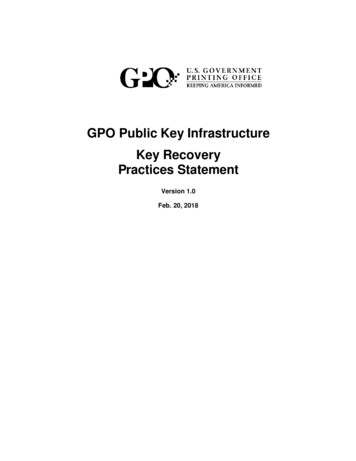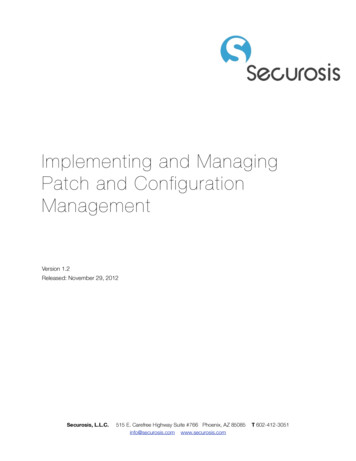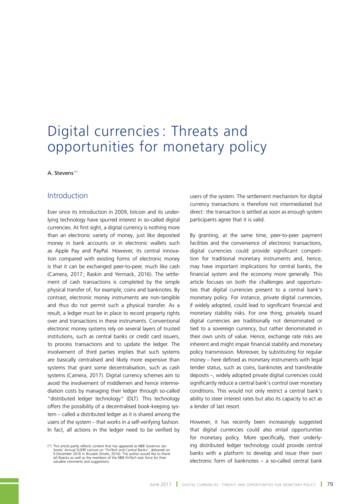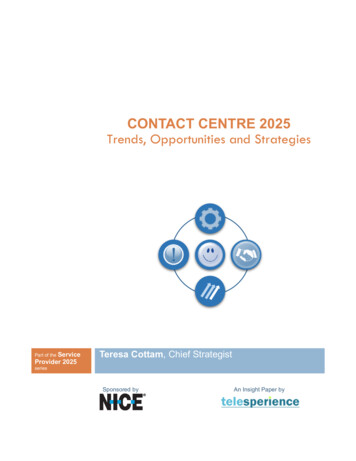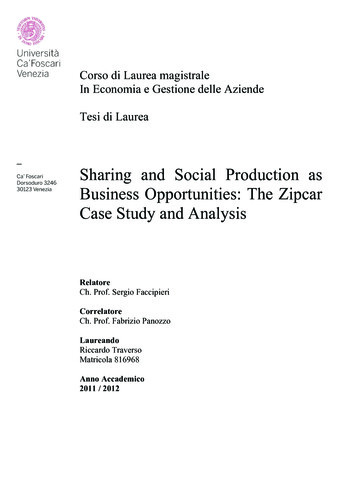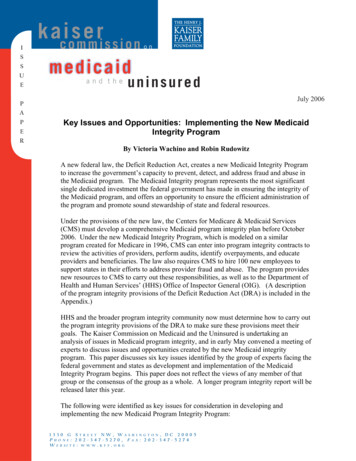
Transcription
ISSUEk aic osmemri s s i o nonmedicaidand theuninsuredJuly 2006PAPEKey Issues and Opportunities: Implementing the New MedicaidIntegrity ProgramRBy Victoria Wachino and Robin RudowitzA new federal law, the Deficit Reduction Act, creates a new Medicaid Integrity Programto increase the government’s capacity to prevent, detect, and address fraud and abuse inthe Medicaid program. The Medicaid Integrity program represents the most significantsingle dedicated investment the federal government has made in ensuring the integrity ofthe Medicaid program, and offers an opportunity to ensure the efficient administration ofthe program and promote sound stewardship of state and federal resources.Under the provisions of the new law, the Centers for Medicare & Medicaid Services(CMS) must develop a comprehensive Medicaid program integrity plan before October2006. Under the new Medicaid Integrity Program, which is modeled on a similarprogram created for Medicare in 1996, CMS can enter into program integrity contracts toreview the activities of providers, perform audits, identify overpayments, and educateproviders and beneficiaries. The law also requires CMS to hire 100 new employees tosupport states in their efforts to address provider fraud and abuse. The program providesnew resources to CMS to carry out these responsibilities, as well as to the Department ofHealth and Human Services’ (HHS) Office of Inspector General (OIG). (A descriptionof the program integrity provisions of the Deficit Reduction Act (DRA) is included in theAppendix.)HHS and the broader program integrity community now must determine how to carry outthe program integrity provisions of the DRA to make sure these provisions meet theirgoals. The Kaiser Commission on Medicaid and the Uninsured is undertaking ananalysis of issues in Medicaid program integrity, and in early May convened a meeting ofexperts to discuss issues and opportunities created by the new Medicaid integrityprogram. This paper discusses six key issues identified by the group of experts facing thefederal government and states as development and implementation of the MedicaidIntegrity Program begins. This paper does not reflect the views of any member of thatgroup or the consensus of the group as a whole. A longer program integrity report will bereleased later this year.The following were identified as key issues for consideration in developing andimplementing the new Medicaid Program Integrity Program:1330 G STREET NW, WASPHONE: 202-347-5270, FW E B SI T E : W W W . K F F . O R G, DC 20005: 202-347-5274H I N G T O NA X
1) Using a broad-based approach can help to ensure program integrity. Simplystated, program integrity is setting policy and managing the Medicaid program to ensurethat health and long-term care services are provided to beneficiaries as effectively andefficiently as possible. As such, a broad-based view of program integrity would help toensure that:xxxxxxxPeople who are eligible for Medicaid are aware of, and enrolling in, the programappropriately;Beneficiaries are receiving high quality care, and that health and long-term careservices provided under Medicaid are appropriate and meet beneficiaries’ needs;Providers are receiving appropriate payment for providing care to Medicaidbeneficiaries;Providers who provide care to Medicaid beneficiaries meet basic participationstandards established by the state;Providers and beneficiaries receive clear guidance describing program rules andrequirements;Payments and services meet the requirements that are established in state andfederal law;Quality health care or state and federal tax dollars are not being put at riskthrough violations of the rules or abuses of the system.Meeting this definition of program integrity would mean that all the elements of settingpolicy and managing the Medicaid program are strong and functioning well. Theseelements include claims processing, coordination of benefits, provider enrollment,provider education and guidance systems, provider payment, quality assurance andclinical management, as well as identification and investigation of aberrant behavior andreferral of suspected cases of fraud and abuse to appropriate enforcement and prosecutionagencies.Frequently, program integrity is defined much more narrowly, focusing on cases of fraudand abuse and criminal misconduct that result in large recoveries or settlements for thegovernment. But focusing solely on enforcement of the rules and prosecution of cases inwhich program rules have been violated misses the much larger picture of managing aprogram to ensure that care is provided in an appropriate and efficient manner and in away that prevents quality care and public funds from being placed at risk. In this largerpicture, preventing violations of program integrity and avoiding inappropriate costs is atleast as important as enforcement of cases of fraud and abuse, even if the monetaryeffects of these efforts are harder to quantify.2) Close collaboration between the states and the federal government is key to thesuccess of implementing the Medicaid Integrity Program. In implementing theMedicaid Integrity Program, a collaborative effort between the states and the federalgovernment will help to ensure that the federal/state nature of Medicaid is accommodatedand that duplication and confusion are minimized as the Medicaid Integrity Programbegins. Collaboration will help address several challenges inherent in carrying out theMedicaid Integrity Program:3
xEnsuring program integrity is primarily a state responsibility. States areresponsible for carrying out their Medicaid programs within a broad set of federalguidelines. As such, states bear most of the responsibility for ensuring programintegrity. States set policy (for example, deciding who is eligible, what benefitsare offered, and how much providers are paid) and manage nearly all of theprocesses and systems that ensure program integrity (enrolling providers andbeneficiaries, managing claims and other data systems, and identifying andinvestigating aberrant patterns of behavior.) In contrast, the federalgovernment’s role in ensuring program integrity has historically been one ofinterpreting federal rules for states and providing support and oversight of stateprogram integrity activities. i The federal government, through the HHS Office ofInspector General and the Department of Justice, also has responsibility forinvestigating and enforcing federal fraud and abuse laws (Figures 1 and 2).Figure 1Federal Program Integrity ResponsibilitiesCMS responsibilities Interpreting federal requirements for states and providersProviding training and guidance to statesMonitoring and enforcing state compliance with federal rules,including fraud and abuse rulesReviewing state agency performance through on site reviewsEnsuring quality of institutional care through developing surveyprotocol and conducting “look behind” surveysThe Medicare-Medicaid claims data matching programProviding financial support for state activities through matchingfundsOIG responsibilities Monitoring and enforcing compliance with federal fraud and abuselaws that apply to providersAudits, evaluations, and investigationsSanctions (civil monetary penalties, exclusions)Negotiating and enforcing provider corporate integrity agreementsagreed to during settlements of fraud and abuse casesAdministering grants to, oversight of, and certification of MFCUsK A I S E R C O M M I S S I O N O NMedicaid and the UninsuredFigure 2State Program Integrity ResponsibilitiesState Medicaid agency responsibilities: Beneficiary enrollment; income and eligibility verificationEnrolling providers, setting rates and paying providersMonitoring quality of careOperating Medicaid Management Information Systems (MMIS),Surveillance and Utilization Review Subsystem (SURS), etc.Detecting improper payments and recovering overpaymentsAnalyzing patterns in provider claims and payment (“data-mining”)Preliminary investigation of fraud and abuse; referring fraud cases tothe Medicaid fraud control unit (MFCU)Responsibilities of other state agencies: Medicaid fraud control units investigate and prosecute provider fraudand patient abuse and neglectNursing facility survey and certificationStates also license providers and conduct auditsK A I S E R C O M M I S S I O N O NMedicaid and the Uninsured4
xDifferent states will have different program integrity support needs.Inasmuch as Congress intended the new Medicaid Integrity Program to supportstates’ program integrity efforts, the program will have to offer flexibility toaccommodate program integrity needs that differ substantially across states.Some states may find that the most useful tool they lack in improving programintegrity is designing and procuring a new information technology system thathelps them identify aberrant billing patterns; other states may need moreinvestigative tools; still others will need or want to improve enforcement efforts.Some states may assign priority to educating providers or improving efforts toensure that providers are properly credentialed. A one-size fits all approach to theMedicaid Integrity Program would not allow for flexibility in meeting states’different needs.xThe Medicare Integrity Program model will have to be modified to be appliedto Medicaid. The model for the new Medicaid Integrity Program is the MedicareIntegrity Program, which was created in 1996 to strengthen the federalgovernment’s ability to ensure program integrity in Medicare. But Medicare isrun entirely by the federal government, with assistance from contractors thatprovide a limited degree of regional variation. The design of the MedicaidIntegrity Program will have to fit the federal/state structure of Medicaid, andensure that the resources it provides both support states in their efforts to ensureprogram integrity and accommodate the diversity of state program rules andrequirements. The Medicaid Integrity Program will effectively have to ensurecompliance with the policy, rules and procedures of the Medicaid programs thatare operated by each of the 56 different states and territories. It will be extremelydifficult for the federal government or its contractors to be knowledgeable about,review, and help enforce the rules of each of these 56 different programs. Thiswill be a major implementation challenge for the Medicaid Integrity Program.Moreover, nearly all states have contracted out provision of health care services toa significant share of their Medicaid populations to managed care organizations.Just over sixty percent of the total Medicaid population was enrolled in managedcare as of 2004, according to CMS.ii (The overwhelming majority of theseenrollees are children and non-disabled adults, although some states areincreasingly enrolling seniors and people with disabilities in managed care.) Inmanaged care delivery systems, the state pays a capitated amount to a managedcare entity which then employs or contracts with providers in a network. So,unlike a fee-for-service environment, the managed care entity rather than the statehas a direct relationship with the providers. This creates overlapping programintegrity responsibilities. The state bears responsibility for ensuring that MCObenefits are accessible and meet quality standards, and that coveragedeterminations are consistent with the state’s requirements. Over time, managedcare has posed challenges to states in terms of monitoring service use and qualityof care provided to beneficiaries who are served through MCO arrangements.iiiThe MCO is responsible for ensuring the integrity of the care provided byproviders with whom the MCO contracts. In contrast, managed care currently5
serves only about 15 percent of Medicare enrollees.iv The Medicare IntegrityProgram has therefore focused only to a very limited degree on issues related tomanaged care organizations. New Medicaid program integrity efforts will needan increased emphasis and more sophisticated approaches in this area.x The Medicaid Integrity Program is separate from efforts to ensure theappropriateness of federal payments to states. CMS has over the past severalyears increased the attention and resources the agency devotes to reviewing statefinancing arrangements to ensure that the federal government is makingappropriate payments to states.v While these efforts have focused on ensuring theprogram’s fiscal integrity, the new Medicaid Integrity Program has as its focusensuring program integrity. Medicaid fiscal integrity efforts have at times createdan adversarial relationship between the federal government and states as theystruggle over which party bears financial responsibility for some transactions andservices, and as the federal government ensures that the matching funds itprovides are obtained transparently and spent appropriately by the states.vi Amore collaborative relationship between the federal government and states canhelp to promote successful Medicaid program integrity efforts. This type ofrelationship would reflect shared responsibility for program integrity between thefederal government and the states, with the states maintaining the lion’s share ofthe day to day program integrity responsibilities. It would also reflect the states’and the federal government’s shared interests in maintaining program standards,encouraging appropriate, high quality care, and minimizing financial risks to stateand federal treasuries.3) Cooperation among federal agencies and communication with stakeholders is alsokey to the success of the implementation of the Medicaid Integrity Program. Inaddition to having a close collaboration among the federal government and the states, it isimportant that close coordination occur among the different federal players with a role inassuring program integrity. The Centers for Medicare & Medicaid Services (CMS), HHSOffice of Inspector General, and Department of Justice (DOJ) all share responsibility atthe federal level for ensuring program integrity in health programs, as does theGovernment Accountability Office (GAO). Under the Medicaid program integrityprovisions of the Deficit Reduction Act, consultations among these agencies are required,but consultations alone may be insufficient to ensure the success of the MedicaidIntegrity Program. When CMS implemented the Medicare Integrity Program, OIG, GAOand DOJ partnered in CMS’ implementation efforts, with the active engagement andsupport of high-level CMS leadership. Having these agencies work together also helpedovercome some differences in approach and organizational culture between agencies thatfocus primarily on providing services and those that focus primarily on law enforcement.Similar collaboration between program agencies and law enforcement agencies could bemirrored at the state level involving state Medicaid agencies, state Attorneys GeneralOffices, state Medicaid fraud control units, and state Inspectors General, in those statesthat have them.6
At both the state and federal levels, communication and consultation with contractors,provider and consumer groups early in the process of developing new program integrityefforts could help to ensure that they are aware of and have an opportunity to provideinput about new policies and procedures. This would allow provider groups to identifyconcerns about the manner in which proposed program integrity procedures could affecttheir practices and their ability to provide high-quality care, and to suggest approachesthat would minimize administrative burden.4) One approach to increased Medicaid program integrity efforts would be to focuson areas where the risks are the highest. Although the creation of the new MedicaidIntegrity Program is bringing a substantial new investment of federal funds to ensuringprogram integrity in Medicaid, these resources remain limited: even when funding growsto 75 million in fiscal year 2011, the annual new federal investment in the MedicaidIntegrity Program will be roughly one-tenth of what the federal government currentlyinvests annually in the Medicare Integrity Program.vii Resources at the state level areeven more constrained. Administrative spending in states has historically been low, andover the past several years many states have been cutting back on spending on programmanagement, reducing the size of their state workforces, or both.As the Medicaid Integrity Program gets underway, one approach to implementation couldbe to focus on a few areas where the financial risks and/or risks to quality have beenhighest (Figure 3). This approach would give the federal government and the states thehighest return on their investment. The program could, for example, focus on providerbilling issues. Historically, a significant number of large Medicaid fraud and abuse caseshave involved provider billing problems.viii In these cases providers bill the program forservices that have not been provided, or “upcode” to claim reimbursement for servicesthat are compensated at a higher rate than the services that were actually provided, oroverstate the number of services that were provided. A similar and significant set ofbilling issues exists with respect to suppliers of medical equipment. Another potentialfocus could be on issues related to the Medicaid drug rebate. There have been a numberof recent cases in which drug manufacturers have engaged in strategies involving thestructure of the Medicaid drug rebate, in which the prices of drugs have been erroneouslyreported to and paid for by state Medicaid programs. ix Provider billing and the drugrebate are two areas in which the federal government and states could improve programintegrity efforts and potentially yield the most significant fiscal gains to the program.Concentrating on these areas would be consistent with the emphasis that the DeficitReduction Act placed on the need for the Medicaid Integrity Program to focus oncontrolling provider fraud and abuse.Another priority for the Medicaid Integrity Program could be to address issues related toquality of care. The program could help states improve efforts to determine, measure andensure quality of care to ensure program effectiveness and cost efficiency. Whileincreased quality of care efforts could be enhanced program-wide, one potential area offocus could be to address longstanding concerns related to quality of care arising fromcases of patient abuse and neglect in long term care settings.x While these cases havehistorically been in nursing homes, as long-term care is increasingly being provided in7
the community, efforts at preventing patient abuse and neglect will need to focus on carethat is provided in community and residential settings as well. In contrast to theseprogram integrity challenges, which have been posed by providers and suppliers,instances in which the actions of beneficiaries have raised significant program integrityquestions are rare; reports from the General Accounting Office and HHS InspectorGeneral on Medicaid program integrity over the past several years identify very fewissues with respect to beneficiary fraud. The risks to the program from beneficiary fraudare extremely small, particularly when they are viewed relative to the risks that have beenposed by some providers.Figure 3Key Issues in Medicaid Fraud and AbuseActivityProvider TypeDrug Rebate“Gaming”Drug Manufacturer Concealing best price Marketing the spreadBilling FraudHospitals,physicians, DMEsuppliers, clinicallabs, pharmacies,home health,transportation Billing for Services Not Provided Upcoding Overstating services provided (i.e.,quantities of drugs provided) DrugDiversionPhysician,pharmacy Buying/selling diverted drugs Unnecessarily prescribing drugs inexchange for kickbacks Quality ofCareLong-term Care Patient abuse and neglect Services not provided as specified Falsified cost reports Acute Care Providing unnecessary services Services provided by inappropriate orunlicensed pro
program created for Medicare in 1996, CMS can enter into program integrity contracts to review the activities of providers, perform aud
